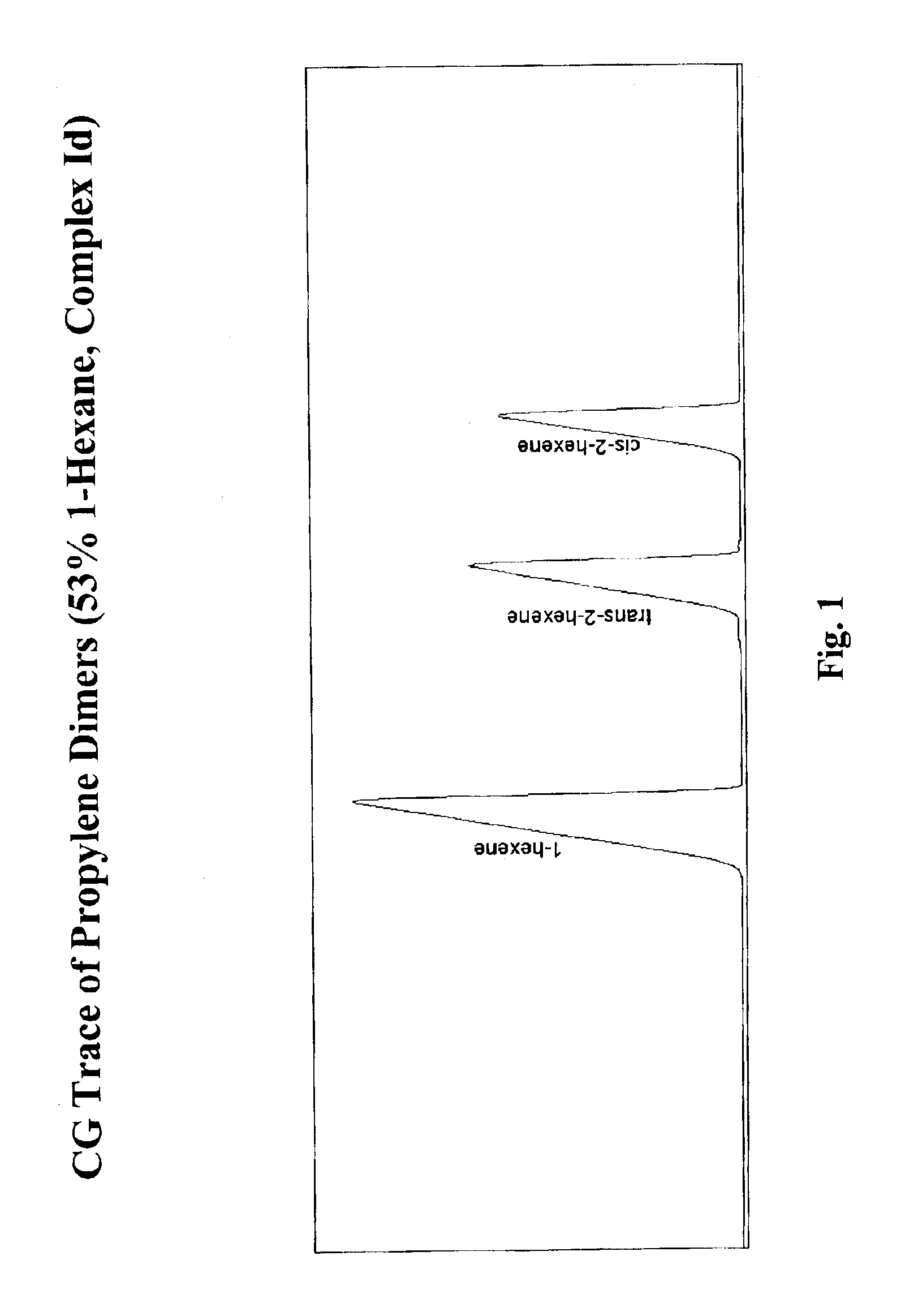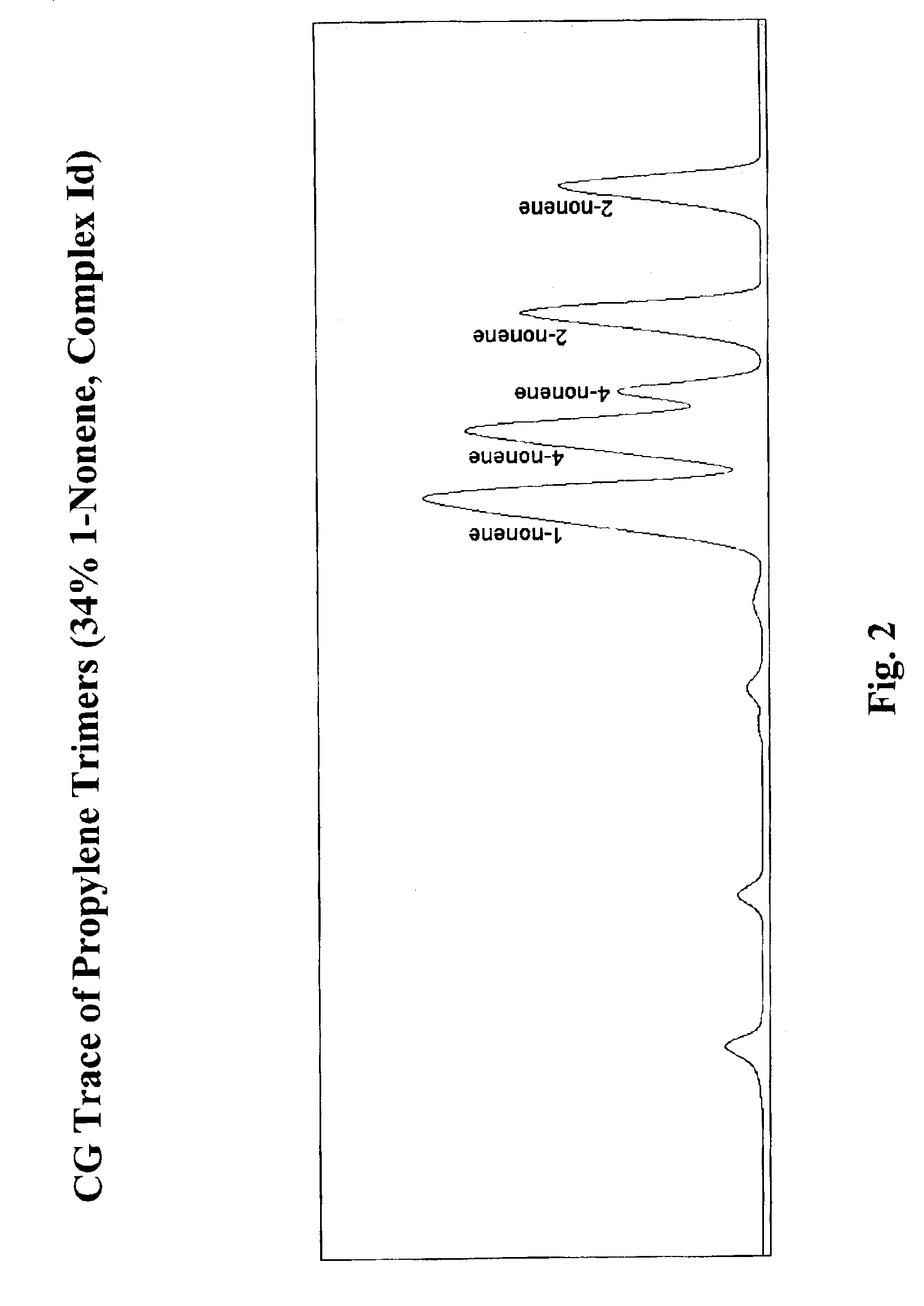Selective isomerization and linear dimerization of olefins using cobalt catalysts
a technology of olefins and catalysts, which is applied in the field of olefin catalysis, can solve the problems of no known method of selectively making linear internal olefins or alpha-olefins from propylene, and achieve the effect of increasing the weight percent of one or more of the dimers, trimers, tetramers and pentamers
- Summary
- Abstract
- Description
- Claims
- Application Information
AI Technical Summary
Benefits of technology
Problems solved by technology
Method used
Image
Examples
example 1
Preparation of Cobalt Complexes of Formula Ia-Id
[0097]Precatalyst complexes were synthesized, as were the ligands used to make the complexes.5-7
[0098]In general, the ligands were prepared by dissolving 2,6-diacetylpyridine and a slight excess (>2 eq.) of the appropriate aniline in methanol, heating the solution for one day under inert atmosphere with a catalytic amount of acetic acid, and recrystallizing the isolated solid from ethanol. The cobalt complexes were prepared by stirring a slight excess of the tridentate ligand with cobalt(II) chloride hexahydrate in THF for at least one day, then adding pentane to the solution and removing the precatalyst complexes by filtration. The complexes were all isolated in near-quantitative yield. Elemental analyses for complexes Ib-Id were carried out to determine the amount of THF in the isolated precatalysts. The solids were heated under vacuum at 40° C. prior to analysis. Complexes Ib and Ic tested positive for an equivalent of THF, but com...
example 2
Isomerization of 1-Hexene to 2-Hexene
[0102]Approximately 3.5 liters of 1-hexene was added to a 5 L flask with stirring. The flask was fitted with a reflux condenser. The hexene was degassed overnight. 21 ml of modified methyl aluminum oxane (MMAO) (density 0.73, 7 weight percent Al) was added via syringe, then stirred for approximately 10 minutes. 110 mg of cobalt complex Ia was quickly added to the flask. The mixture then heated up from 22° C. to 39° C. within 2-3 minutes. A bucket of water was used to cool the reaction mixture externally. After 6 hours, 17% of 1-hexene remained. After 3 days, 70% of the mixture was converted to t-2-hexene, 9% was converted to 3-hexene, and 20% was c-2-hexene.
example 3
Procedure for Dimerization of Liquefied Gases
[0103]Under inert conditions, the appropriate cobalt complex was weighed out and added to an NMR tube. A small amount of methylene chloride was added to solublize the complex, and the tube was sealed. The sealed tube was then tied, using copper wire, to the internal cooling coils of a clean, dry Zipperclave™ reactor. The reactor was evacuated and then placed under static vacuum. A glass charger was then used to transfer the cocatalyst to the reactor, and the reactor was back-filled with Argon. The liquefied gas cylinder was pressurized with a head pressure of Argon, and placed on a scale with ±5 g accuracy. Flexible hose was used to connect the gas cylinder to the reactor, and the desired amount of olefin was delivered to the reactor using the head pressure of the cylinder. The reactor was pressurized further with argon to ensure that the olefin remained in the liquid phase. Stirring was begun resulting in breakage of the NMR tube and act...
PUM
| Property | Measurement | Unit |
|---|---|---|
| weight percent | aaaaa | aaaaa |
| weight percent | aaaaa | aaaaa |
| weight percent | aaaaa | aaaaa |
Abstract
Description
Claims
Application Information
 Login to View More
Login to View More - R&D
- Intellectual Property
- Life Sciences
- Materials
- Tech Scout
- Unparalleled Data Quality
- Higher Quality Content
- 60% Fewer Hallucinations
Browse by: Latest US Patents, China's latest patents, Technical Efficacy Thesaurus, Application Domain, Technology Topic, Popular Technical Reports.
© 2025 PatSnap. All rights reserved.Legal|Privacy policy|Modern Slavery Act Transparency Statement|Sitemap|About US| Contact US: help@patsnap.com



